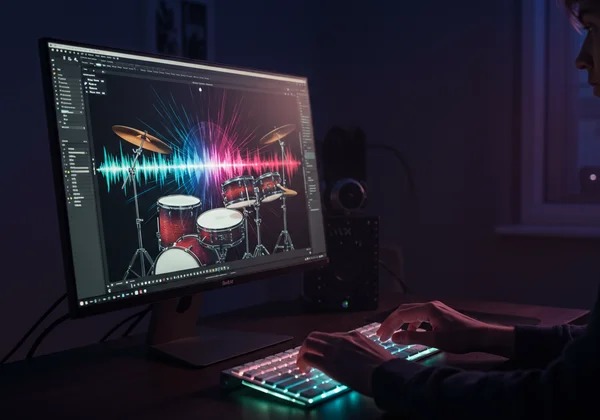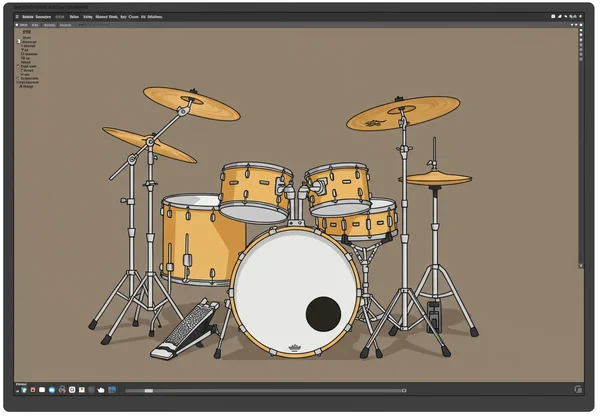Easy Drum Fills for Your Virtual Drums: 5 Keyboard Drumming Patterns
You’ve mastered that basic rock beat on your keyboard, the classic "boom-bap" that gets your head nodding. It feels great, but after a while, you might notice it sounds a little… repetitive. You hear professional drummers throwing in exciting, flashy licks that connect different parts of a song, and you wonder, how can I make my keyboard drumming sound more dynamic? The secret is learning easy drum fills.
In this guide, we'll break down the magic of drum fills and teach you five simple yet powerful patterns you can start playing right now. These fills will transform your basic beats into complete, exciting musical statements. The best part? You can practice them all for free on our online drum kit.
What Is a Drum Fill, Anyway?
Think of a drum fill as a short, creative break from the main rhythm. It's a "fill" because it fills the space between musical sections, like moving from a verse to a chorus. Instead of just keeping time, you're adding personality and signaling to the listener that something new is about to happen. It's the difference between walking down a street and doing a cool little spin before turning a corner.
Fills make your drumming sound intentional and professional. They add tension, release, and excitement, turning a simple groove into a compelling performance. Using an online drum simulator is the perfect way to get a feel for how these work without any pressure.

The Secret Sauce: Why Fills Make Beats Better
A good fill acts as a musical phrase that connects two ideas. Its primary job is to create a seamless transition between different parts of a song. Imagine a song building up to a powerful chorus; a fast, rolling fill can create that exciting buildup, making the chorus feel even more impactful when it arrives. They are the punctuation marks of drumming—the commas, exclamation points, and periods that give your rhythm structure and flair.
Perfect Timing: When to Play a Drum Fill
The most common place to play a drum fill is in the last measure of a four or eight-bar phrase. Music is often organized into these predictable blocks. You would play your main beat for three measures and then use the entire fourth measure to play your fill, leading perfectly into the next section.
Don't worry if "bars" and "measures" sound complicated. For now, just think of it as "play your beat a few times, then play your fill." As you listen to more music, you'll start to naturally hear the moments where drummers use fills to create these transitions. You can start developing this sense of timing right now.
5 Beginner Drum Fills for Your Keyboard
Ready to get your fingers moving? Here are five simple fills designed specifically for keyboard drumming. Each one uses the intuitive key layout on our virtual drum kit. Remember to click the "Show Key" button on our site to see the mapping on each drum!

Fill #1: The Simple Tom-Tom Roll
This is the first fill every drummer learns—and for good reason! It sounds awesome and is super easy to play. It’s a simple, descending roll down the tom-toms that is perfect for adding a touch of melody to your rhythm.
- Description: A classic four-note pattern moving from the high tom to the floor tom.
- Keyboard Keys:
U(High Tom) ->I(Mid Tom) ->O(Low Tom) ->P(Floor Tom) - How to Play: Simply press the keys in sequence, keeping the timing even. Try to make it sound like one smooth motion. Ready to give it a shot? Try this on our virtual drums.
Fill #2: The Classic Snare & Tom Combo
This fill introduces the snare drum, adding a sharp, punchy sound to the pattern. It's a versatile fill that works in rock, pop, and funk music, making it an essential tool for your rhythmic vocabulary. This pattern helps build hand-to-hand coordination.
- Description: A four-note pattern alternating between the snare and toms.
- Keyboard Keys:
J(Snare) ->J(Snare) ->U(High Tom) ->I(Mid Tom) - How to Play: Hit the snare twice to establish a punch, then move smoothly across the toms. This one is all about crispness. Feel the rhythm and play it online.
Fill #3: The Four-on-the-Snare Buildup
Sometimes, the simplest fills are the most effective. This pattern uses only the snare drum to build tension before a big chorus or musical change. It’s a powerful tool for creating anticipation.
- Description: Four evenly spaced notes played on the snare drum.
- Keyboard Keys:
J->J->J->J - How to Play: The key here is dynamics. Start soft and get progressively louder with each hit to create a classic crescendo. This will make the next beat feel huge. Head over to our free drum machine and see how much energy you can create.
Fill #4: The "Around the Kit" Journey
This fill takes you on a quick tour of the drum kit, creating a more complex and impressive sound. It combines the snare, toms, and floor tom for a full-bodied drum pattern that feels great to play.
- Description: A flowing pattern that moves across the kit from snare to floor tom.
- Keyboard Keys:
J(Snare) ->U(High Tom) ->O(Low Tom) ->P(Floor Tom) - How to Play: This fill is about creating a sense of movement. Keep your finger movements fluid as you travel from the snare across the toms. It’s a fun one to master and sounds incredibly professional. You can start practicing now.
Fill #5: The Simple Crash Ending
Every good statement needs a strong ending. This fill provides a clean and powerful conclusion by finishing with a satisfying crash cymbal. It’s the perfect way to resolve the tension you’ve built.
- Description: A simple tom roll that ends with a definitive crash cymbal hit.
- Keyboard Keys:
U(High Tom) ->I(Mid Tom) ->O(Low Tom) ->Y(Crash Cymbal) - How to Play: Play the three tom notes and then land firmly on the crash cymbal right as the next beat is supposed to start. It’s a fantastic way to punctuate your drum beat. Give it a final smash on your virtual drum set.
How to Practice Your Keyboard Drum Fills
Knowing the patterns is one thing, but integrating them smoothly into your playing is the next step. Practice is key, and our online virtual drums are the perfect place to hone your skills without bothering the neighbors.
Start Slow and Stay in Time
The biggest mistake beginners make is trying to play fills too fast. Speed is not the goal; rhythm is. Start slowly and make sure each note is evenly spaced. Focus on playing the fill perfectly in time before you try to speed it up. Your muscle memory will thank you later. A steady hand is more impressive than a fast, sloppy one.

Connecting Beats and Fills Together
Now, let's put it all together. Here’s a simple exercise you can do right now on our platform:
- Play a basic rock beat for three full counts (e.g., Bass-Snare-Bass-Snare).
- On the fourth count, play one of the fills you just learned.
- Land back on the main beat on the "one" of the next measure.
- Repeat!
This drill will teach you how to move seamlessly between keeping time and adding fills, which is the essence of great drumming.
Unleash Your Inner Drummer Today!
You no longer have to be stuck playing the same repetitive beat. With these five easy drum fills, you have the tools to make your keyboard drumming sound more exciting, dynamic, and professional. You've learned what fills are, when to play them, and have five patterns ready to go.
So what's next? Simple: stop reading and start playing! Fire up those virtual drums and let's get these fills under your fingers. Head over to our interactive virtual drum set, pull it up for free, and start working these fills into your playing today. Unleash your inner drummer and have fun creating your own awesome rhythms!
Frequently Asked Questions About Learning Drums Online
How do you play drum fills on a computer keyboard?
Playing drum fills on a computer keyboard is easy and intuitive, especially with a tool like our online drum simulator. Our platform maps each drum and cymbal to a specific key on your keyboard. You simply press the keys in sequence, just like we outlined above, to perform a fill. We even have a "Show Key" feature that displays the correct key on each drum piece, so you can learn visually.
How can I practice drums without a drum set?
You can effectively practice drums without a drum set by using an online drum simulator. A high-quality virtual drum set gives you access to a full kit with realistic sounds, directly in your web browser. This is the perfect solution for beginners who face constraints with budget, space, or noise. It allows you to practice coordination, timing, and patterns like fills anytime, anywhere.
Is it too late for me to learn drums?
It is absolutely never too late to learn drums! Drumming is a skill that can be enjoyed at any age. The key is having access to the right tools and a passion for rhythm. Platforms like ours remove the traditional barriers to entry, making it easy for anyone to start. The journey of learning an instrument is about personal enjoyment and expression, not a race against time. So go ahead and start your journey today.